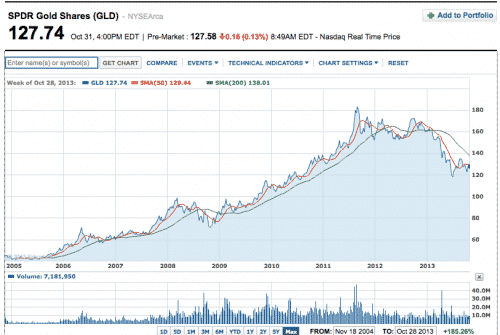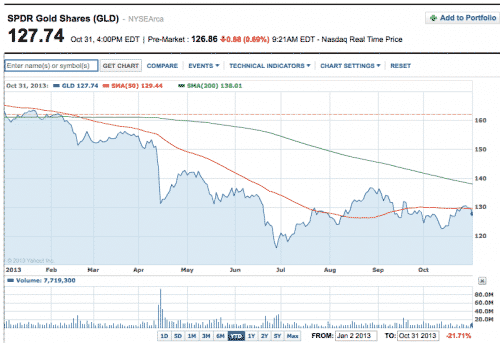How’s gold doing?
Today’s commentary
Summary: The chart on gold is not looking very good. And it seems that retail investors have lost interest in the precious metal. Is this a correction within the longer-term gold bull market or is it a new secular bear market for gold? I have some thoughts below?
I don’t like talking about gold because it is not an investment which lends itself to rational and logical analysis based on traditional valuation metrics. But I am going to try to put some logic to it here as precious metals are an investment sector which cannot be overlooked given the historical importance and the outperformance of precious metals over the last decade.
But gold has been breaking down in a big way since a peak in 2011. Why? In January 2012, when I predicted that gold would break down, I put it this way:
“Surprise #9: Gold continues to lose its luster: gold wins when financial repression, defined as negative real interest rates, is the greatest. The higher the gap between inflation and long rates is, the higher gold will go because it goes from being a burden that has zero yield to being an asset that holds purchasing power amid government-sponsored wealth destruction. I think the inflation cycle has peaked. European inflation is coming down, Indian inflation and Chinese inflation are coming down. And policy rates, particularly in the US and Europe have no room to go much lower. That’s not gold bullish.”
The essence of what I was saying in 2012 is that gold is not really an inflation hedge. If one looks at the charts, gold doesn’t really do that well in that regard. As an alternative investment, I see Its first role as a hedge against declining or negative real interest rates. Gold earns nothing. So it is a burden compared to interest-bearing assets and therefore becomes relatively more attractive only when interest-bearing assets yield less in real terms.
For example, in Japanese yen terms, gold looks good now because of Abenomics. With Japanese yields barely moving higher and deflation receding, real interest rates in Japan are declining. Gold should do well in that environment. But of course, the yen has depreciated significantly and one could easily capture the decline in real rates through a currency carry trade instead of an investment in gold.
Last year, I went to an inflation-linked product conference where I was a speaker on one panel. I noted after the conference that “AllianceBernstein had done serious leg work in getting price data back to the 1890s on commodity prices. And what they found was a correlation between commodity prices and the rate of change in inflation, meaning that, historically, commodities have been a decent hedge for rising inflation.” But, what does that mean vis-a-vis currency carry trades or real assets like real estate? Wouldn’t you rather own farmland as an inflation hedge?
Again, I do not dislike gold. I just think there are other ways to achieve the same ends.
So what is the breakdown in gold signalling then? When I last talked about this in April I noted that Marc Faber thought it could be a signal that inflation and inflation expectations were breaking down. And now, 7 months later we see European inflation at 4-year lows of 0.7% and US inflation well below target at 1.2%.
Disinflation is something to keep an eye on because of the high levels of private debt. High private debt equals lower retail sales growth which equals slowing inflation which in turn means debt burdens do not shrink as fast in real terms. And this therefore is a negative feedback loop which retards growth. When one adds in the tighter fiscal environments in the US and Europe, you can understand why the recoveries have been so weak. Central banks see this and remain accommodative in order to boost asset prices that they hope will feed through into the real economy and break the negative feedback loop of high private debt. But we are still just treading water and that means rising real yields in Europe and the US, which is gold bearish.
Now, if you look at the chart of the gold ETF, what you see is gold plunging well below 50- and 200-day daily moving averages until just recently when the market price of the gold ETF was within range of the 50-day DMA. Technical analysts saw the oversold gold position in June as ripe for a rally and we got that rally through September. But it has faded as declining real interest rates have taken their toll.
The bottom line is that it’s hard to be bullish on gold right now. I don’t see any positive catalysts. Indeed, I am fearful of the breakdown in inflation and the increase of real interest rates in a zero rate and high private debt environment. This is an especially toxic mix when banks are carrying a huge load of dud assets that have yet to be written down. In the euro zone alone, Ernst and Young estimates banks have 940 billion euros of bad debt on their books, 7.8% of credit outstanding. And that is 120 billion euros more than in 2012. To me, this speaks to credit contraction and continued deleveraging in Europe.
For now, I am neutral to negative on gold.


Comments are closed.